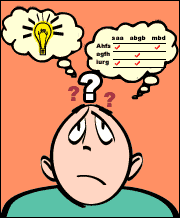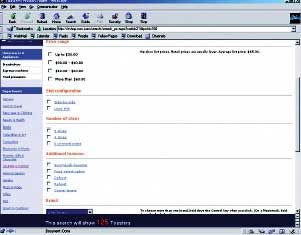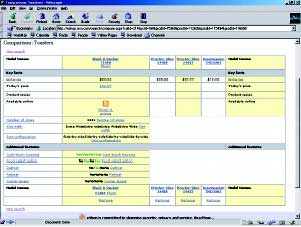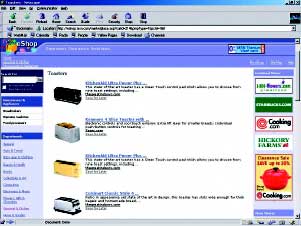Cool stuff and UX resources
Introduction
Psychologists and Economists who study how people make decisions describe two types of decisions: compensatory and non-compensatory.

Compensatory decisions
Compensatory decisions are rational decisions. They involve:
- identifying the complete set of attributes that could impact the success of choosing any of the available options – including both positive and negative impacts,
- assigning a relative importance to each attribute,
- computing an overall value for each option based on the impact of attribute and relative weight, and
- selecting the option with the best value.
In compensatory decisions, when the final values for attributes are computed, negative attributes can be compensated for by equal or higher value positive attributes. For instance, a plane ticket that costs $50 more (negative attribute) may ultimately be the better choice because it is a direct flight (positive attribute).
Compensatory decisions are rational. However, people don't make compensatory decisions. Collecting and comparing all of the necessary data is simply too labor intensive.
Non-compensatory strategies are heuristics for decision making
In reality, we typically make non-compensatory decisions. This happens when people:
- don't collect all the relevant information systematically,
- fail to consider the relative importance of various attributes, or
- do not trade off the benefits of some attributes against the deficits of others.
Non-compensatory decision making essentially shortcuts the compensatory process to make the decision making process easier. For instance, in the airline example above, decision makers may simply not collect information on all the relevant attributes. In our airline example, they may consider price but not stopovers or overall flight time.
Alternately, people may find the task of comparing the tradeoffs too much. Instead of weighing price against layover, they may adopt strategies like "drop the choice with negative attributes." Continuing the example, under this strategy the higher priced ticket goes without consideration of the longer travel time. In reality, human decisions all include non-compensatory decision strategies.
"Satisficing," introduced by Herbert A. Simon in his Models of Man in 1957, is a term that combines "satisfy" and "suffice". Satisficing is a non-compensatory decision strategy in which we select the first adequate option, failing to explore or consider the entire set of options. Web site users do this all the time when they quickly scan a page until they get to the first hopeful sounding link name and click that. In a compensatory process they would read all the possible links, identify the most promising one, and then click.
CompareNet


Jango

Decisions by design
Could thoughtful information design help users make better consumer choices? Seems like it should. One benefit of the Web is that it simplifies the task of comparison shopping across merchants. The task that used to involve walking back and forth across the mall can now be accomplished in a fraction of the time – without moving from your desk chair. Merchants can organize and present all of the relevant information right at our finger tips to make the decision making process even easier. With relatively minimal work we can use the Web to make a well researched, informed, and even more rational decisions, right?
Unfortunately, shopping sites are not always created with the goal of comparative decision making in mind. How many times have you been online and thought I should be able to make a much better decision, but the site doesn't let me compare...?
There are exceptions. Some sites try to help users make better, or more compensatory decisions. But, does it help?
In a recent study, Jedetski, Adelman and Yeo (2002) hypothesized that Web sites designed to make comparing alternatives easier would lead users to better (or more compensatory) decisions than Web sites that do not. Before starting the study, they briefed their participants on the difference between compensatory and non-compensatory decision strategies so that they could reflect on the decision strategies that they used. After the briefing, participants used two target Web sites (CompareNet and Jango) to select items to purchase.
CompareNet allowed users to specify and display attributes side-by-side, and then compare among the alternatives. The site also facilitated comparison by providing the ability to sort on criteria such as price or reviews. Columns of attributes could easily be added or removed.
In contrast, Jango presented alternatives in a list for users to sort, but direct comparison required clicking deeper into the site, printing pages, or taking notes on the side. On Jango comparison was possible, but it certainly was not made easy.
Participants shopped independently for answering machines, baby monitors, golf clubs, and toasters. Data was collected using the "think-aloud" protocol. In this process participants think out loud while they shop so that the experimenters can note which attributes are noticed and considered. The "think aloud" procedure provides the experimenters a window to some of the mental processes of how participants made their decisions.
At the end of each "shopping" task, participants and researchers independently indicated whether the participant had used compensatory or non-compensatory strategies for that trial.
Both the researchers and participants agreed that participants were significantly more likely to use a compensatory strategy on CompareNet than on Jango.
Assuming that decision effort is relatively constant within individuals, these findings indicate that site design influences the quality of the participants' decisions. By presenting the information in a format that supported the selection and comparison of critical attributes, CompareNet clearly increased the use of compensatory decision strategies. In economic terms, participants made better decisions when they were using CompareNet.
Participants also reported greater satisfaction with CompareNet. While this is not surprising (we like to think we make good decisions), it is important. The perception that a site is helping or hindering customers to make better decisions, ultimately has impact on brand.
It's not rocket science...
Jedetski and colleague's work shows that the way information is presented on sites influences users decision-making processes. Users recognize when they are making good decisions (as opposed to satisficing) and they prefer sites that help them do that.
Other Web site options that support positive decision making include:
- sorting by price (which entails showing the price...something that sites STILL regularly fail to do!),
- prioritizing decision attributes so that critical options (e.g., price or travel time) appear early, and
- providing assistance or information to help shoppers unfamiliar with a product determine what the relevant parameters of consideration might be (e.g., in Jedetski's study, some participants were not familiar with what to consider when shopping for baby monitors.)
At a time in which many sites still bury prices, merchants and site designers who appreciate the usability of site interactions, and its effect on their brand, are starting to think in more sophisticated ways to support consumer decision making. Users feel better about themselves when they think they've made a solid and well considered decision. That halo may well extend to the merchant in the form of site loyalty.
References
Jedetski, J. Adelman, L., & Yeo, C. (2002). How web site decision technology affects consumers. IEEE Internet Computing, 6(2), 72-79.
Message from the CEO, Dr. Eric Schaffer — The Pragmatic Ergonomist
Leave a comment here
Reader comments
Dara McLaughlin Project Webmaster Boeing IDS
This was a great issue. Case in point, compare the Toyota car site with the Honda car site. I was looking for a car recently, and mainly want to choose between Toyota and Honda. The Toyota car site allows me to rank all their models vs. cost or mpg or seating. The Honda site only shows price in a comparison screen. Living in LA makes mpg critical information. I felt much more inclined to go buy a Toyota car because I feel like their site gives me the decision criteria I need in an easy to find format.
Toyota: click on the top bar Vehicles, then Model selector
Honda: and click on the Honda icon on the right, and then select the all models link on the right
Ray Williamson
Consulting Engineer
I've long used a "compensatory decision process" without knowing it was called that, and for large decisions will use a spreadsheet. I see "satisficing" as either consistent with that process, or at the very worst lazy, but not naturally at odds.
It seems to me that comparison shopping has value – either positive or negative – in the decision process the same as other factors listed: It takes time, and can be either enjoyable or not. Depending on the perceived value of time in a situation, people will behave differently.
Comparison shopping for food items by price has a positive value for the lower income shopper. Comparison shopping for ingredients has a positive value for the health-conscious consumer. It has a negative value based on the time investment for the person on lunch hour, where a decision NOW means more time for the individual.
Comparison shopping for hobby items such as fishing reels almost always has a positive value, because hobbies are essentially pastimes and the shopping process extends the pursuit without substantially increasing the cost.
The goal should be for a Web site designer or business owner to first define their clientele and facilitate the process accordingly. The Tire Rack is a good example. The consumer can simply identify their car and their climate, and get two or three recommendations and an order form. The enthusiast can spend days searching the database of specifications and reviews, and even see how the choice will look on their car.
Subscribe
Sign up to get our Newsletter delivered straight to your inbox
